|
|
What is Aeronautics?
| Dynamics of Flight | Airplanes
| Engines | History
of Flight | What is UEET?
Vocabulary | Fun
and Games | Educational Links |
Lesson Plans | Site Index | Home
|
|
How Did We Learn to Fly Like the Birds?
|
Myths and Legends of Flight
Greek Legend - Pegasus
Bellerophon the Valiant, son of the King of Corinth, captured Pegasus, a winged
horse. Pegasus took him to a battle with the triple headed monster, Chimera.
Icarus and Daedalus - An Ancient Greek Legend
Daedalus was an engineer who was imprisoned by King Minos. With his son, Icarus,
he made wings of wax and feathers. Daedalus flew successfully from Crete to
Naples, but Icarus, tired to fly too high and flew too near to the sun. The
wings of wax melted and Icarus fell to his death in the ocean.
King Kaj Kaoos of Persia
King Kaj Kaoos attached eagles to his throne and flew around his kingdom.
Alexander the Great
Alexander the Great harnessed four mythical wings animals, called Griffins,
to a basket and flew around his realm.
Early Efforts of Flight
Around 400 BC - China
The discovery of the kite that could fly in the air by the Chinese started humans
thinking about flying. Kites were used by the Chinese in religious ceremonies.
They built many colorful kites for fun, also. More sophisticated kites were
used to test weather conditions. Kites have been important to the invention
of flight as they were the forerunner to balloons and gliders.
Humans try to fly like birds
For many centuries, humans have tried to fly just like the birds. Wings made
of feathers or light weight wood have been attached to arms to test their ability
to fly. The results were often disastrous as the muscles of the human arms are
not like a birds and can not move with the strength of a bird.
Hero and the Aeolipile
|

Aeolipile
|
The ancient Greek engineer, Hero of Alexandria, worked with air pressure
and steam to create sources of power. One experiment that he developed
was the aeolipile which used jets of steam to create rotary motion.
Hero mounted a sphere on top of a water kettle. A fire below the kettle
turned the water into steam, and the gas traveled through pipes to the
sphere. Two L-shaped tubes on opposite sides of the sphere allowed the
gas to escape, which gave a thrust to the sphere that caused it to rotate.
|
1485 Leonardo da Vinci - The Ornithopter

Leonardo da Vinci's Ornithopter
|
Leonardo da Vinci made the first real studies of flight in the 1480's.
He had over 100 drawings that illustrated his theories on flight.
The Ornithopter flying machine was never actually created. It was a
design that Leonardo da Vinci created to show how man could fly. The
modern day helicopter is based on this concept.
|
1783 - Joseph and Jacques Montgolfier- the First Hot Air
Balloon
|
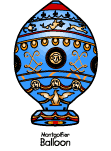
One of The Montgolfier's Balloons
|
The brothers, Joseph Michel and Jacques Etienne Montgolfier, were inventors
of the first hot air balloon. They used the smoke from a fire to blow
hot air into a silk bag. The silk bag was attached to a basket. The hot
air then rose and allowed the balloon to be lighter-than-air.
In 1783, the first passengers in the colorful
balloon were a sheep, rooster and duck. It climbed to a height of about
6,000 feet and traveled more than 1 mile.
After this first success, the brothers began to send men up in balloons.
The first manned flight was on November 21,
1783, the passengers were Jean-Francois Pilatre de Rozier and Francois
Laurent.
|
1799 - 1850's - George Cayley

One Version of a Glider
|
George Cayley worked to discover a way that man could fly. He designed
many different versions of gliders that used the movements of the body
to control. A young boy, whose name is not known, was the first to fly
one of his gliders.
Over 50 years he made improvements to the gliders. He changed the shape
of the wings so that the air would flow over the wings correctly. He designed
a tail for the gliders to help with the stability. He tried a biplane
design to add strength to the glider. He also recognized that there would
be a need for power if the flight was to be in the air for a long time.
|
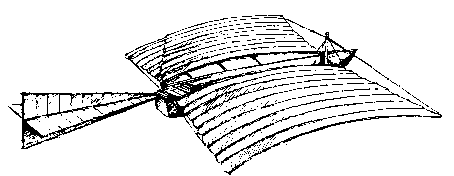
One of the many drawings of gliders
Cayley wrote On Ariel Navigation which shows that a fixed-wing aircraft
with a power system for propulsion and a tail to assist in the control of the
airplane would be the best way to allow man to fly.
19th And 20th Century Efforts
1891 Otto Lilienthal
|
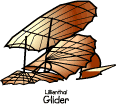
One of Lilienthal's Gliders
|
German engineer, Otto Lilienthal, studied aerodynamics and worked to
design a glider that would fly. He was the first person to design a glider
that could fly a person and was able to fly long distances.
He was fascinated by the idea of flight. Based on his studies of birds
and how they fly, he wrote a book on aerodynamics that was published in
1889 and this text was used by the Wright Brothers as the basis for their
designs.
After more than 2500 flights, he was killed when he lost control because
of a sudden strong wind and crashed into the ground.
|
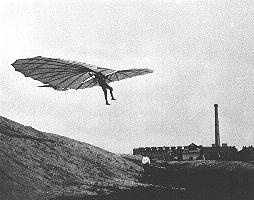
Lilienthal's Glider in Flight
1891 Samuel P. Langley
|

Langley's Aerodrome
|
Samuel Langley was an astronomer, who realized that power was needed
to help man fly. He built a model of a plane, which he called an aerodrome,
that included a steam-powered engine. In 1891, his model flew for 3/4s
of a mile before running out of fuel.
Langley received a $50,000 grant to build a full sized aerodrome. It
was too heavy to fly and it crashed. He was very disappointed. He gave
up trying to fly. His major contributions to flight involved attempts
at adding a power plant to a glider. He was also well known as the director
of the Smithsonian Institute in Washington, DC
|
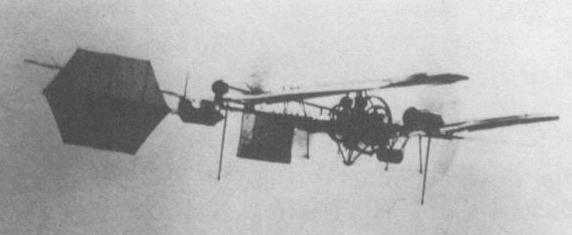
Model of Langley Aerodrome
1894 Octave Chanute
Octave Chanute published Progress in Flying Machines in 1894. It gathered
and analyzed all the technical knowledge that he could find about aviation accomplishments.
It included all of the world's aviation pioneers. The Wright Brothers used this
book as a basis for much of their experiments. Chanute was also in contact with
the Wright Brothers and often commented on their technical progress.
Orville and Wilbur Wright and the First Airplane
Orville and Wilbur Wright were very deliberate in their quest for flight.
First, they read about all the early developments of flight.
They decided to make "a small contribution" to the study of flight control by
twisting their wings in flight.
Then they began to test their ideas with a kite. They learned about how the
wind would help with the flight and how it could affect the surfaces once up
in the air.
|
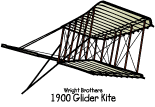
A Drawing of a Wright Brothers Glider (1900)
|
The next step was to test the shapes of gliders much like
George Cayley did when he was testing the many different shapes that would
fly. They spent three years testing and learning about how gliders could be
controlled at Kitty Hawk, North Carolina. |
|
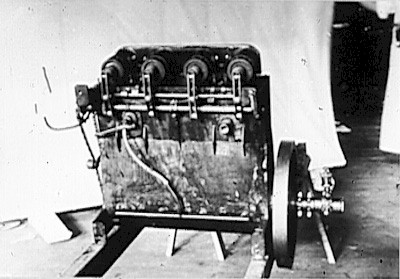
Picture of the actual 12 horsepower engine used in
flight
|
They designed and used a wind tunnel to test the shapes of the wings
and the tails of the gliders. In 1902, with a perfected glider shape, they
turned their attention to how to create a propulsion system that would
create the thrust needed to fly.
The early engine that they designed generated almost 12 horsepower. That's the same power
as two hand-propelled lawn mower engines!
|
|

The Wright Brother's Flyer
|
The "Flyer" lifted from level ground to the north of Big Kill
Devil Hill, North Carolina, at 10:35 a.m., on December 17, 1903. Orville piloted the plane
which weighed about six hundred pounds.
|
|
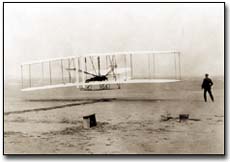
Actual Flight of The Flyer at Kitty Hawk
|
The first heavier-than-air flight traveled one hundred twenty feet in
twelve seconds. The two brothers took turns flying that day with the fourth and last
flight covering 850 feet in 59 seconds. But the Flyer was unstable and very
hard to control.
The brothers returned to Dayton, Ohio, where they worked for two more years perfecting
their design. Finally, on October 5, 1905, Wilbur piloted the Flyer III for 39 minutes
and about 24 miles of circles around Huffman Prairie. He flew the first practical
airplane until it ran out of gas.
|
Humankind was now able to fly! During the next century, many new airplanes
and engines were developed to help transport people, luggage, cargo, military
personnel and weapons. The 20th century's advances were all based on this first
flights by the American Brothers from Ohio.
Back to top
What is Aeronautics?
| Dynamics of Flight | Airplanes
| Engines | History
of Flight | What is UEET?
Vocabulary | Fun
and Games | Educational Links | Site
Index | Home
